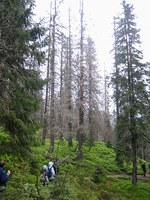Tree mortality in the Black Forest on the rise - climate change a key driver
Freiburg, Aug 23, 2023
Climate impacts such as dry, hot summers reduce the growth and increase the mortality of trees in the Black Forest because they negatively influence the climatic water balance, i.e., the difference between precipitation and potential evapotranspiration. That is the central finding of a long-term study of the influence of climate and climate change on trees in the Black Forest conducted by Prof. Dr. Hans-Peter Kahle and Prof. Dr. Heinrich Spiecker, who are both professors of forest growth and dendroecology at the University of Freiburg. The researchers used a consistent time series of 68 years (1953 to 2020) as the basis for their research. It covers the annual mortality of all trees in an almost 250-thousand-hectare area of the public forests in the Black Forest. They analysed these data in comparison with a second data series on the climactic water balance for the months of May to September. The results of their research have been published in the scientific journal Global Change Biology.
Tree mortality peaked in 2019
“Our time series on tree growth and mortality in the Black Forest is unique and allows quantitative analysis of the impacts of heat and drought,” says Kahle. Together with his colleague, he examined trees that died as a result of insect or fungal infestation, atmospheric deposition, frost or drought, and of other causes.
The time series on climatic water balance – which covers 140 years (1881-2020) – shows a continuous downward trend. “Also reflected in this analysis is the tree mortality at the end of the last century known as ‘Forest Dieback I’. In the Black Forest, its extent can be explained solely by weather conditions and the associated bark beetle infestation,” explains Spiecker. At that time, however, a maximum of twelve percent of the sustainable annual growth died off, yet the mortality rate after extremely dry summers in recent years has increased to 40 percent of sustainable annual growth. Sustainable growth describes the sum of the average annual growth of wood which is used as a basis for calculating the annual allowable sustainable timber harvest. In 2019, mortality reached a peak at more than seven times the average mortality rate in the period from 1953 to 2017. Kahle elaborates, “What is also striking is a certain regularity in the occurrence of cool-humid and warm-dry periods that repeated themselves in the past around every fourteen years. But we’ve observed that the cool-humid periods are becoming weaker while the warm-dry periods are getting more severe.”
- Original publication: Heinrich Spiecker, Hans-Peter Kahle. Climate-driven tree growth and mortality in the Black Forest, Germany – Long-term observations. In: Global Change Biology (Journal Code: GCB). Article DH_ID: 17785198. https://onlinelibrary.wiley.com/doi/10.1111/gcb.16897
- Prof. Dr. Hans-Peter Kahle is an adjunct professor of forest growth and dendroecology at the Institute of Forest Sciences of the University of Freiburg. His focus in on the topics of growth and productivity of forest trees and stands, forest yield science and dendroecology.
- Prof. Dr. Dr. h.c. mult. Heinrich Spiecker is also a professor of forest growth and dendroecology at the Institute of Forest Sciences of the University of Freiburg. He retired in 2015 but continues to carry out research with emphases on forest growth and the environment, controlling forest growth, agroforestry, and methodology.
Press images for download
Contact:
University and Scientific Communications
University of Freiburg
Tel.: 0761/203-4302
E-Mail: kommunikation@zv.uni-freiburg.de



